Tuesday 20 June, 2006, 12:11 - Radio Randomness
Having gone on about how to extend the range of a wireless LAN using a high gain antenna, the need suddenly arose for the range of my own WiFi connection to be extended so I though I would purchase a 9dBi antenna to see what happened. Being a hardcore engineer, I wanted to try and see whether this antenna really delivered the gain over the original 2dBi antenna which it promised.Antennas and laptop in hand, I used a programme called 'Netstumbler' to record the signal to noise of the reception of my WiFi connection over about a 1 hour period, changing between the standard 2dBi and the higher-gain 9dBi antenna about half way through. The first graph (below) shows the received signal strength over the period. The orange line is the rolling average over a 2 minute period. Without any further analysis, it is immediately apparent that the signal strength received when the 9dBi antenna is installed is higher than with the 2dBi antenna, indicating that it did have some gain as promised.
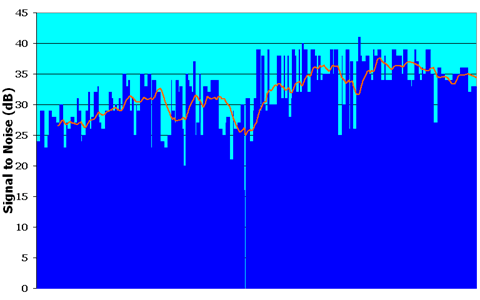
A quick calculation of the average over the 2 periods showed that the average signal to noise with the 2dBi antenna was 28.8dB, whereas the average signal to noise with the 9dBi antenna was 34.6dB, an increase of 5.8dB - not quite the 7dB increase that should in theory materialise, but not bad nonetheless. For the statisticians amongst you, the standard deviation in both cases was remarkably close at 3.96 and 3.92 dB for the 2 and 9 dBi antennas respectively, indicating that the signal was equally stable (despite the obvious variations) in both instances.
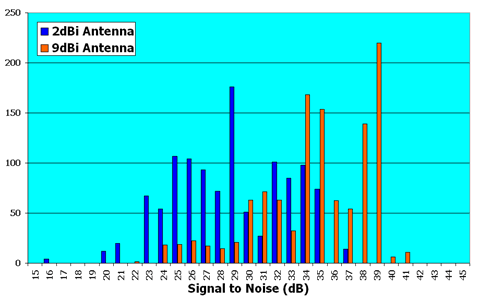
A further analysis of the results (above) shows the distribution of signal strengths produced by the 2 antenns. In this case it is easy to see that the signal produced by the 9dBi antenna (in orange) is consistantly and significantly better than that of the 2dBi antenna (in dark blue).
Whilst the experiment was less than scientific, taken at face value, it does suggest that the signal produced by the 9dBi antenna is a worthwhile improvement over the signal produced by the standard 2dBi antenna as supplied with most WiFi routers. The claims of a '3 to 4 times' increase in the range of coverage have not been tested - maybe I'll do that one day soon.
add comment
( 1257 views )
| permalink
| 



 ( 2.9 / 15038 )
( 2.9 / 15038 )




 ( 2.9 / 15038 )
( 2.9 / 15038 )
Wednesday 14 June, 2006, 08:22 - Amateur Radio
For a while now, I've been considering how best to go about installing a decent multi-band HF antenna that would be unobtrusive but still work. I first tried a long inverted-L made of thin wire running down the garden using the house-hold central heating system as an earth (yes, yes, I know this is a no, no, but it's all I could get my hands on in the area available). It wasn't totally invisible but was largely unobtrusive. It resonated at about 2.5 MHz and with a simple ATU I could tune it to get a low SWR on all bands from 160m (the top end only) to 6m. Of course it's difficult to measure the effectiveness of such an antenna but I did manage one or two true 'DX' contacts with Hong Kong (5976 miles), Tokyo (5915 miles) and Sao Paulo (5984 miles) on bands ranging from 17 to 10 metres. The downside to the antenna was that it received rather a lot of background noise, probably because the vertical portion of the 'L' ran close to lots of IT equipment. I also discovered that next door's television was a major source of RF interference on 20 metres too! However, I couldn't help but feel that performance was probably not even as effective as a straightforward dipole. Having measured my loft, I realised that I only had about 9 metres of space to play with - enough for a 17 metre dipole, but not much more. After a bit of digging around I found an antenna made by WiMO of Germany, which used the fact that, below their resonant frequency, tuned 'L-C' traps become inductors and as such have the effect of electrically shortening an antenna. With clever positioning of two sets of traps, they have produced a trapped-dipole that covers 20, 15 and 10 metres in an overall, occupied space of only 8 metres. This sounded like just the thing for my loft so I ordered one. A week later it arrived.
However, I couldn't help but feel that performance was probably not even as effective as a straightforward dipole. Having measured my loft, I realised that I only had about 9 metres of space to play with - enough for a 17 metre dipole, but not much more. After a bit of digging around I found an antenna made by WiMO of Germany, which used the fact that, below their resonant frequency, tuned 'L-C' traps become inductors and as such have the effect of electrically shortening an antenna. With clever positioning of two sets of traps, they have produced a trapped-dipole that covers 20, 15 and 10 metres in an overall, occupied space of only 8 metres. This sounded like just the thing for my loft so I ordered one. A week later it arrived.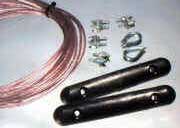 Installation was a cinch, mounting the centre balun transformer from a hook at the apex of the loft, and dangling the two antenna wires over the rafters to sit as close to the roof (and thus as high) as possible. I quickly ran to the shack to see whether or not such an antenna could cope with being in such a confined space (where, I should add, there are electrical cables feeding loft lights as well as a television antenna, splitter and various down-leads and a loft ladder, all of which could de-tune the antenna). A quick tune around and I have to say I was impressed: with no tweaking at all, the antenna provided a perfect 1:1 match at 28.0, 21.05 and 14.15 MHz - a little low in frequency for SSB working - but the match is relatively wide and a little intervention from my MFL-902 'Travel Tuner' ATU quickly solved that problem (oddly, the setting to raise the resonant frequency was the same on all 3 bands...)
Installation was a cinch, mounting the centre balun transformer from a hook at the apex of the loft, and dangling the two antenna wires over the rafters to sit as close to the roof (and thus as high) as possible. I quickly ran to the shack to see whether or not such an antenna could cope with being in such a confined space (where, I should add, there are electrical cables feeding loft lights as well as a television antenna, splitter and various down-leads and a loft ladder, all of which could de-tune the antenna). A quick tune around and I have to say I was impressed: with no tweaking at all, the antenna provided a perfect 1:1 match at 28.0, 21.05 and 14.15 MHz - a little low in frequency for SSB working - but the match is relatively wide and a little intervention from my MFL-902 'Travel Tuner' ATU quickly solved that problem (oddly, the setting to raise the resonant frequency was the same on all 3 bands...)How does the antenna perform? At the moment it's difficult to say. I haven't really had enough time to see whether its DX performance can equal my inverted-L, but what I can say is that (a) subjectively, signals on 10, 15 and 20 metres seem a good bit stronger all round than they did before and that (b) my neighbour's television now gives S9 of noise on 20m instead of S7!
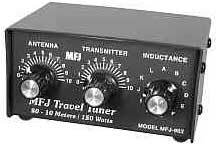 One final note - whilst my ATU will tune the antenna on the 12, 17, 30 and even 40 metre bands, unlike the inverted-L which comprised nothing other than a piece of wire, the WiMo antenna has a 1:1 balun at the centre. This ensures a much better match with the coax feed, and means that the coax down-lead does not radiate. However it does mean that, if the feed-point impedance of the antenna is not near 50 Ohms, there is a potential for much of the power travelling up the feeder to be absorbed by the balun, rather than making it to the antenna. Thus, whilst it might be possible to tune the antenna on these bands, there is a significant danger of burning out the balun - sodon't do it!
One final note - whilst my ATU will tune the antenna on the 12, 17, 30 and even 40 metre bands, unlike the inverted-L which comprised nothing other than a piece of wire, the WiMo antenna has a 1:1 balun at the centre. This ensures a much better match with the coax feed, and means that the coax down-lead does not radiate. However it does mean that, if the feed-point impedance of the antenna is not near 50 Ohms, there is a potential for much of the power travelling up the feeder to be absorbed by the balun, rather than making it to the antenna. Thus, whilst it might be possible to tune the antenna on these bands, there is a significant danger of burning out the balun - sodon't do it!Tuesday 6 June, 2006, 08:22 - Radio Randomness
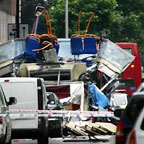 A London Assembly report published yesterday (5 June 2006) into the events surrounding the terrorist attack on London on 7 July 2005 identified that the major problem suffered by the emergency services at the event was the lack of adequate radio communications. It identified that, other than the British Transport Police, none of the radio systems used by police, fire or ambulance services functioned on the London Underground. Further, it goes on to note that the different radio systems used by the different emergency services means that they are unable to effectively communicate from one service to another. It also states that the reliance on mobile phones by the emergency services (in particular the Ambulance service and for communication between senior officers) was effectively an accident waiting to happen.
A London Assembly report published yesterday (5 June 2006) into the events surrounding the terrorist attack on London on 7 July 2005 identified that the major problem suffered by the emergency services at the event was the lack of adequate radio communications. It identified that, other than the British Transport Police, none of the radio systems used by police, fire or ambulance services functioned on the London Underground. Further, it goes on to note that the different radio systems used by the different emergency services means that they are unable to effectively communicate from one service to another. It also states that the reliance on mobile phones by the emergency services (in particular the Ambulance service and for communication between senior officers) was effectively an accident waiting to happen.What's perhaps surprising is that none of these problems were unknown. There have been plans afoot for over 10 years to install radio communications across the London Underground, including in tunnels. The project, known as 'Connect' was awarded to a consortium in 2000. The original plan was to install infrastructure across the underground to support both 'TETRA' based communications for the tube trains themselves as well as to support cellular communications. However technical difficulties have meant that the project has now been restricted to just providing TETRA for cab-to-control communications. The project is still in a 'beta' phase with no actual radios in service.
Since the emergency services first used radio, each of the services had its own radio system. In times of crisis, each service established a mobile headquarters, often in the back of a van, and as long as each services' HQ was parked near the other services, communications between the different services could be achieved by shouting from van to van, or by running hand-written paper notes between them. The events in London, however, occured in several different and diverse locations and with improvements in communication and information technology, there is less of a need for a remote HQ as everything can be dealt with from the regular HQ. As such, communication between the services is now worse than it might have been 10 or 15 years ago and in a situation such as the terrorist attacks on London last July, would have been virtually non-existent.
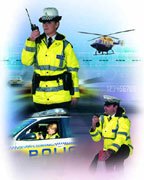 There is light at the end of the tunnel, however, in the form of 'Airwave'. Airwave is a TETRA based radio service being rolled-out across the UK for use by all the emergency services. Initially intended just for the police, Airwave has now been adopted by the ambulance and fire services too. Once roll-out is complete, all three main emergency services will be using the same radio technology and the same radio system so inter-service communications should be much more straight forward.
There is light at the end of the tunnel, however, in the form of 'Airwave'. Airwave is a TETRA based radio service being rolled-out across the UK for use by all the emergency services. Initially intended just for the police, Airwave has now been adopted by the ambulance and fire services too. Once roll-out is complete, all three main emergency services will be using the same radio technology and the same radio system so inter-service communications should be much more straight forward.It is a well understood fact that, in times of crisis, usage of mobile phones rockets. Everyone near or involved in the crisis will wish to contact their relatives to tell them they are OK, or to call the emergency services to try and garner assistance. Mobile networks are not designed to handle such high loads and the inevitable result is severe congestion and in some cases, network failure. With this in mind, the GSM specification includes a number of features to try and ensure that emergency service users can continue to communicate at such times. Access overload class (ACCOLC) is a UK designed system in which ACCOLC enabled mobiles are given priority access to a cellular network.
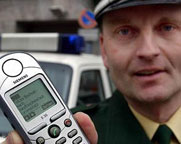 Each ACCOLC mobile phone is assigned a priority from 1 to 15 (normal users are randomly assigned a priority in the range 1 to 10, whilst emergency users have priorities 11 to 15). The network selectively disables the lower priority mobiles to ensure that higher priority communications can continue. Thus priorities 1 to 5 may be disabled, randomly cutting off half of all civilian users and thus freeing the network for emergency communications. There is also a feature of GSM (version 2+) known as enhanced multi-level precedence and pre-emption (eMLPP) - this too allows priority access for certain users, however it is not commonly implemented on many commercial GSM networks being reserved for those networks designed to support railway communications (GSM-R).
Each ACCOLC mobile phone is assigned a priority from 1 to 15 (normal users are randomly assigned a priority in the range 1 to 10, whilst emergency users have priorities 11 to 15). The network selectively disables the lower priority mobiles to ensure that higher priority communications can continue. Thus priorities 1 to 5 may be disabled, randomly cutting off half of all civilian users and thus freeing the network for emergency communications. There is also a feature of GSM (version 2+) known as enhanced multi-level precedence and pre-emption (eMLPP) - this too allows priority access for certain users, however it is not commonly implemented on many commercial GSM networks being reserved for those networks designed to support railway communications (GSM-R).So from the perspectives of the communication abilities of the UK emergency services, the attacks came just at the right (or is that wrong) time, during a period of transition and when sub-terranean communications were not at their best. It is to be hoped, therefore, that even if the atrocities had not taken place, the situation would be improving. With the publishing of the London Assembly report, let us pray that adequate communications are in place before anyone else decides to take a pop at the innocent people of our capital city (or any other part of the UK or the world for that matter).
Thursday 4 May, 2006, 09:08 - Spectrum Management
One question which many unlicensed radio users of any kind (e.g. pirate radio operators) often ask themselves is, "What are the chances of me getting caught?" Clearly there is a lot of illegal radio usage which goes on, some of it over very prolonged periods of time, or at regular intervals, so not all transmitters get closed down.Let's start by examining the tools available to the 'powers that be' which they can use to track down naughty radio transmitters. Most of the devices used would come under the umberella term of direction finding (DF) equipment, which often forms part of an overall spectrum monitoring system which logs details of all radio usage.
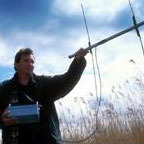 The DF equipment informs the operator the direction from which a transmission is emanating. If such equipment is located in (or moved to) several locations within the coverage of a transmitter, the resulting direction measurements can be combined using triangulation and the location of the errant transmitter identified. The accuracy of such equipment varies: Fixed units can provide measurements to within +/- 1 degree whereas portable units may only have a resolution of +/- 10 degrees. With a resolution of 1 degree, it is not uncommon that the location of a transmitter can be identified to within about 500 metres, even with fixed receivers on the outskirts of the area of interest. Portable units are of more use close-in where the utmost accuracy is less important as the distances involved are much smaller and thus even +/- 10 degrees allows a transmitter to be located within 100 metres or so.
The DF equipment informs the operator the direction from which a transmission is emanating. If such equipment is located in (or moved to) several locations within the coverage of a transmitter, the resulting direction measurements can be combined using triangulation and the location of the errant transmitter identified. The accuracy of such equipment varies: Fixed units can provide measurements to within +/- 1 degree whereas portable units may only have a resolution of +/- 10 degrees. With a resolution of 1 degree, it is not uncommon that the location of a transmitter can be identified to within about 500 metres, even with fixed receivers on the outskirts of the area of interest. Portable units are of more use close-in where the utmost accuracy is less important as the distances involved are much smaller and thus even +/- 10 degrees allows a transmitter to be located within 100 metres or so.The last 100 metres become the most difficult. At this point the signal from the transmitter becomes so strong that direction finding equipment fails and the person doing the tracking has to resort to more traditional methods. By far the most useful method to find a transmitter when you are within 100 metres of it is to look! At this distance, the antenna may be easily visible - for pirate FM broadcasters, the 'double stack' aerials roughly strewn on top of tower blocks are a dead giveaway.
So tracking down illegal radio users is relatively straightforward and, for a continuous transmission, can be done in a couple of hours. Most (modern) radio regulators or administrations have the necessary equipment. Some even know how to use it. For sporadic or occasional transmissions, the authorities have to be ready to pounce, which is one of the reasons that so many pirate radio stations are only on-air at weekends when most radio enforcement officers are watching the football, playing golf or enjoying time with their families.
But there is a further question which needs asking... "What would cause the authorities to look for a transmission in the first place?" The simple answer is usually: Interference.
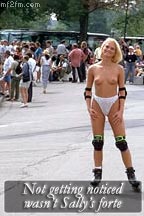 If an unauthorised radio transmitter is not causing anyone a problem, it will largely go unnoticed. If, however, it is causing interference to another radio user, that user will notice and will usually go straight to the authorities. For pirate stations, this situation is ameliorated by the fact that legitimate broadcasters might see a pirate as a problem, not because of interference, but because the station is taking its listeners away and thus has the potential to damage its advertising revenue (or so they would claim). The main exception to this is in certain bands where the authorities tend to use their monitoring equipment regularly, knowing in advance that illegal operation takes place. This might include, for example, the 6.6 MHz 'Echo Charlie' illegal CB band, well known pirate short-wave frequencies, or indeed the FM band itself.
If an unauthorised radio transmitter is not causing anyone a problem, it will largely go unnoticed. If, however, it is causing interference to another radio user, that user will notice and will usually go straight to the authorities. For pirate stations, this situation is ameliorated by the fact that legitimate broadcasters might see a pirate as a problem, not because of interference, but because the station is taking its listeners away and thus has the potential to damage its advertising revenue (or so they would claim). The main exception to this is in certain bands where the authorities tend to use their monitoring equipment regularly, knowing in advance that illegal operation takes place. This might include, for example, the 6.6 MHz 'Echo Charlie' illegal CB band, well known pirate short-wave frequencies, or indeed the FM band itself.So what are the chances of being caught? Once you get noticed, the chances are relatively high. Keep your head down and don't tread on anyone's toes and you might just get away with it.

